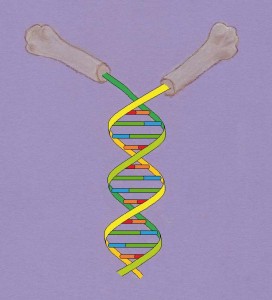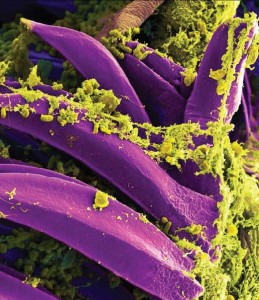MONDAY, 3 FEBRUARY 2014
Genetic evidence has been vital for identifying criminals since the first use of DNA fingerprinting in 1986. Now the burgeoning field of ancient DNA is revealing the identity of a very different class of killers – ancient plagues and pestilences. New technologies are uncovering the fascinating stories of the pathogens responsible for bubonic plague, the Irish potato famine, and leprosy. Piecing together the genome sequences of these ancient pathogens allows us to understand how epidemics develop, and can help scientists to understand whether or not these pathogens have the power to spread and kill on a pandemic scale in the future.DNA can be extracted from the remains of people and animals who died hundreds or thousands of years ago. However, these ancient DNA samples have typically degraded over time and are consequently composed of short fragments of DNA, which have different chemical characteristics to modern, longer DNA sequences. The genomes of two ancient human cousins, the extinct Neanderthals and Denisovans, have been reassembled using whole-genome shotgun sequencing. This is a technique that can piece together short DNA fragments without needing to know in advance which parts of the genetic code the fragments correspond to. As a result, it is now possible to isolate DNA from many ancient sources, including animals, plants and microscopic pathogens, and read their full genetic code. Leprosy, caused by the bacterium Mycobacterium leprae, used to be a common and debilitating disease. It is now rarely found in Europe and the developed world, but still flourishes in many developing countries, with 225,000 cases a year. Leprosy can cause damage to the nerves, skin, eyes and limbs, resulting in the formation of lesions and loss of sensation; secondary infections lead to the loss of tissue and the deformities classically associated with the disease. An important question remains: why did leprosy vanish from Europe before the arrival of effective treatments? Unlocking the secrets of the ancient M. leprae genome has provided some clues.
Starting with the bones of medieval leprosy victims from across Europe, researchers led by Verena Shuenemann isolated M. leprae DNA from the skeletal remains. Although extracting the DNA of bacteria from bones has been possible for 20 years, assembling whole genomes using this DNA has only recently become feasible. A key challenge has been isolating the DNA of the bacterium of interest from that of other abundant bacteria and the DNA of the human host. To achieve this, the researchers used DNA array capture technology, whereby artificial DNA ‘baits’ with sequences matching short segments of the known genome sequence of modern M. leprae separate out the DNA of the leprosy bacteria from that of other bacterial species and the human host. Interestingly, Shuenemann and colleagues found M. leprae DNA to be better preserved than host DNA from the same sample. This is probably because the unique waxy composition of Mycobacteria protected the DNA from degradation by heat, water and other bacteria. By comparing the ancient leprosy strains isolated from the skeletons to modern strains, they were able to trace the origins of those currently present in the Americas to Europe, and show that a strain found only in the Middle East today was once present across northern Europe. Unexpectedly, they found no evidence for a change in the virulence of leprosy over time, suggesting that environmental and social factors or an increase in a human immunity to M. leprae in Europeans led to the disappearance of leprosy in Europe. Future research on the disappearance of M. leprae from Europe will now turn towards studying what these factors could be.
Another bacterium, Yersinia pestis, was responsible for one of the most infamous disease outbreaks in human history: the Black Death. From the earliest reports in Roman times until the early 18th century, bubonic plague caused epidemics across Europe. In the past decade small outbreaks have been reported in India and Madagascar. Interestingly, the modern mortality rates from bubonic plague are considerably lower than the devastating historical estimates, which put some regions of Europe at more than 50 per cent mortality. Therefore, there has been speculation about whether or not Y. pestis was truly responsible for the Black Death, and whether differences between the genomes of ancient and modern day Y. pestis can account for decreased mortality rates. Human teeth from the East Smithfield plague pits in London, which were used in the late 1340s specifically for the interment of plague victims, were potential sources of Y. pestis DNA. The same array capture technology, this time designed to enrich Y. pestis sequences, was used to ‘fish’ for the DNA of this pathogen. It was a successful approach: 94 per cent of the Y. pestis genome was sequenced with high confidence using this technology. Comparisons of this 700-year-old Y. pestis strain with modern strains of bubonic plague did not find sufficient genetic changes to explain the difference in mortality rates between modern outbreaks and the Black Death in the 1340s. As with leprosy, human evolution or an increased standard of living, including better hygiene and less over-crowding, have made this disease less deadly.
Pathogens can also ravage populations by destroying food stocks. The Irish potato famine of 1845-1852, or the Great Hunger, occurred when repeated failures of potato crops led to mass starvation. 2013 saw the publication of the genome of Phytophthora infestans, an algae-like organism responsible for the massive potato die-off, sequenced by Kentaro Yoshida and colleagues. The population has still not returned to pre-famine levels, due in part to the significant death toll and mass emigration that followed the failure of Ireland’s staple crop. As the indirect cause of human death through starvation, the potato blight did not leave behind evidence of its identity in human remains, forcing scientists to go looking for more unusual sources of the pathogen’s DNA. The samples used to isolate P. infestans were rather different from the bones and teeth used in many Yersinia pestis was responsible for the Black Death other ancient DNA studies: here, 150-year-old dried potato leaves kept at Kew Gardens were used. The strain of P. infestans that caused the potato blight was revealed to have originated in the Americas, most likely in the US, at the start of the 19th century. While this strain of potato blight is now extinct, the study reveals the incredible power global trade had, even 150 years ago, to rapidly spread plagues and pestilences around the world. DNA sequencing of historic P. infestans also revealed that the modern strain of this pathogen is actually more virulent than the agent that caused the Great Hunger. Modern pesticides keep potato blight at bay, but there was an outbreak, resulting in famine, in Germany during WWI, as a lack of resources prevented crop spraying.
The recent reconstruction of ancient pests and plagues no longer present in Europe raises the question of where DNA sequencing technology could take us next. Historical disease detectives no longer have to rely on ancient reports of a disease’s symptoms, or hope for an infectious agent that leaves marks on bones or other preserved matter. It is now possible to go directly to suspected victims and sequence ancient DNA in search of a known suspect. With increases in the sensitivity of ancient DNA recovery, and better tools for distinguishing the DNA of a real pathogen from a modern contaminant, scientists will be able to study historic plagues of unknown cause – and perhaps reveal the identity of an ancient killer.
Charlotte Houldcroft is a temporary lecturer in the Department of Archaeology and Anthropology




